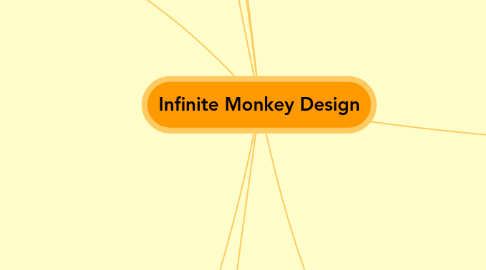
1. Open Source
1.1. Aspects
1.1.1. Communal
1.1.1.1. increases cultural wealth of ideas
1.1.1.2. develops modes of collaboration
1.1.2. Generative
1.1.2.1. Linear
1.1.2.1.1. progress driven development
1.1.2.2. Lateral
1.1.2.2.1. adaptive mutation
1.2. Examples
1.2.1. RIP: A Remix Manifesto
1.2.2. OpenSource Cinema
1.2.3. Open Office
2. Gaming
2.1. Educational
2.1.1. increasing user awareness of ideas and issues
2.2. Experimental
2.2.1. users generating new ideas and concepts
3. Mass Customization
3.1. Individual POV
3.1.1. reduced costs
3.1.2. better met needs
3.1.2.1. performative
3.1.2.2. experiential
3.2. Communal POV
3.2.1. increases % of architect involved design
3.2.1.1. new market for architects
3.2.1.2. increased performance and creativity in housing
3.2.2. potential for greater environmental sustainability
4. Processing
4.1. Human
4.1.1. Centralized
4.1.1.1. Corporate body
4.1.1.1.1. fixed group of participants
4.1.1.2. Individual
4.1.2. Distributed
4.1.2.1. Volunteerism
4.1.2.1.1. relatively community driven
4.1.2.2. Hobbyists
4.1.2.2.1. relatively self interested
4.1.2.3. Crowd Sourcing
4.2. Computer
4.2.1. Centralized
4.2.1.1. Private Computer
4.2.2. Distributed
4.2.2.1. SETI
4.2.3. Software
4.2.3.1. rendering programs
4.2.3.1.1. open source
4.2.3.1.2. closed source
4.2.3.2. Embedded building information
4.2.3.2.1. BIM
4.2.3.3. Web 2.0
4.2.3.3.1. Wiki
4.2.3.3.2. Forums
5. Sustainability
5.1. Socio-Political
5.1.1. communities can grow through open participation in decision making and options generating
5.2. Environmental
5.2.1. reducing the energy, pollution and carbon output of built envirnoments
5.2.1.1. Durability
5.2.1.2. Operating
5.2.1.3. Embodied
5.3. Creative/Cultural
5.3.1. Generating creative commons and sustaining traditions
5.3.1.1. Public vs Privitization
5.3.1.2. Productive vs Commodity
6. Architecture
6.1. Built Form
6.1.1. Envelope
6.1.1.1. Assembly
6.1.1.1.1. Componants
6.1.1.1.2. Labor
6.1.1.2. Performance
6.1.1.2.1. Protection from Weather/Climate
6.1.1.2.2. Relationship to Neighbors
6.1.2. Structure
6.1.2.1. Techtonic
6.1.2.1.1. Members
6.1.2.1.2. Connections
6.1.2.2. Stereotonic
6.1.2.2.1. Form Work
6.1.2.2.2. Composite material
6.1.2.3. Analysis
6.1.3. Design
6.1.3.1. Mass
6.1.3.2. Custom
6.1.3.3. Mass Custom
6.2. Site
6.2.1. Resources
6.2.1.1. Local resources
6.2.1.1.1. Energy Source
6.2.1.1.2. Construction Materials
6.2.1.1.3. Fabrication
6.2.1.2. Foreign
6.2.2. Local Constraints
6.2.2.1. Bylaws/Codes
6.2.2.2. Neighbors
6.2.2.3. Climate/Weather Specificity
6.2.2.4. Access
6.2.2.4.1. Transportation
6.2.2.4.2. Connectivity
6.3. Practice
6.3.1. Typical Practice
6.3.1.1. Designer
6.3.1.1.1. Consultants: Engineers etc, Specialists, etc
6.3.1.2. Client
6.3.1.2.1. Contractors: Builders
6.3.1.3. Occupant
6.3.2. Alternative Practice
6.3.2.1. Community Driven
6.3.2.2. Own/Design/Build
7. GP
7.1. GP1
7.1.1. Research
7.1.1.1. Pro-Amateurs
7.1.1.2. Interactive Design Websites
7.1.1.3. Open Source softwares
7.1.1.4. Games
7.1.1.4.1. SuperStruct
7.1.2. Experimentation
7.1.2.1. Photo to 3D to BIM model
7.1.3. Document
7.1.3.1. Text
7.1.3.1.1. Statement of Intent
7.1.3.1.2. Summery of work
7.1.3.1.3. Body of work
7.1.3.1.4. GP2 Proposal
7.1.3.2. Diagrams
7.1.3.3. Mock-up of a design process experiment
7.1.3.4. Glossary
7.1.3.5. Bibliography
7.2. GP2
7.2.1. Thesis Project
7.2.2. Work Structure
7.2.2.1. Weekly Agenda
7.2.2.2. Committee
7.2.2.3. Defence
7.2.2.4. Book
8. Mark George
8.1. Father
8.1.1. Remixed Identity
8.2. Nintendo Generation
8.2.1. Video Games as social connector
8.2.2. Plug and play
8.2.3. Interaction.
